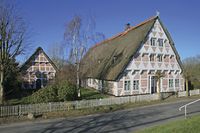53°32'17.7"N 9°36'38.7"E
The Altenteilerhaus in Guderhandviertel
Hereditary right, wealth and architecture
The "Reformatio des Landrechts von 1517" (Reformation of the Land Law of 1517), written down around 1580, contained legal instructions from the Landgräftings to the lower courts in the Altes Land.
The matrimonial property regime
Matrimonial joint property prevailed in the Altes Land. Therefore, each spouse had equal rights, even if the contribution each had made was not equal. In 1789, there was a verdict according to which the sale of land was declared invalid because the wife's consent was missing.
The hereditary right
If one of the spouses died, the other one had to share half of all property with the children, if there were any, or with the next heirs, however, the estates did not have to be shared. The farms were not to be divided, but the person who left was paid money. If both parents died, descendants had to divide all living and portable inventory equally or sell it to one of them at a fair price; the eldest had to subordinate to the youngest. However, it was possible that a daughter could also inherit the farm. This was why girls were also well educated in the Altes Land.
The reason for this was the concern that if the farms were divided, the population could become poorer and the safety of the dykes would have been endangered, since it required efficient property.
Furthermore, each land acquisition was subject to confirmation by the responsible dyke association of the mile. Following a decision of 1554, they had the right to judge whether the purchaser was “nochhaftig erkannt wörde, Dike und Damme to maken, darmit unses Gnädigen Herrn Land vorwaret si” (“capable of dyking so that our gracious lord's land is reserved”). If the buyer's ability and good will were not assumed, and people were very careful in these matters, he/she had to present “söben beedete (vereidete) und besetene Lüde to Borgen”; seven owners who had to bail for him/her.
Handing over the farm and life estate:
If the farm was to be handed over while the parents were still alive, then the rights and obligations of the parents as well as of the heir were also specified in detail in a so-called contract of sale and hand-over. The heir of the farm usually had to take over all debts and duties and commit himself to certain payments in cash and non-cash benefits to the parents, i.e. the life estate, and siblings, thus a dowry or a compensation.
The Näherecht (right of proximity)
Moreover, relatives to the third degree could claim, e.g. preemption at the relevant lower court within a certain period of time; in the absence of relatives, even the neighbouring landowner could claim a "right of proximity". This right was also intended to prevent the land from being divided. The Bisprake was valid until 1845.
Wealth was important for survival and was demonstrated.
The magnificent gables of numerous Altländer Fachhallenhäuser (low German houses), especially from the Baroque period, have a richly patterned brick infill. They are called tessellated brickwork (Buntmauerwerk). European mistletoe, windmills, suns, lozenges, wattle and daub, herringbone patterns and friezes demonstrate the bricklayers’ creativity and skills as well as the wealth of the builders. It is controversial among historians whether the patterns were of Germanic origin, protective symbols or merely ornaments.
The colourfulness of the patterning is highlighted by the white colouring of individual stones and the mortar. Sometimes the yellow "Leydener" stone from the Netherlands is also found in the decorative fields of the framework.
Tessellated brickwork required skilled and experienced craftsmen. The stones had to be prepared carefully with their different bevels so that their edges were not damaged. It was necessary to work carefully and precisely from the design to the right mortar mixture.
The proportions of the gables follow the rules of the golden section. In comparison with other regions, the richness of shapes in the gable design of the Altländer Fachhallenhäuser is particularly great and unique.
The most beautiful gables have been preserved in Guderhandviertel and Bergfried since they are aligned east and are thus more protected from the weather.
The Altenteilerhaus Guderhandviertel No. 50a
This is the oldest preserved half-timbered building in the Altes Land. The engraving in Gothic minuscules says: „ANNO DNI 1587 Heinriche thom velde düt hus int werck laten stellen Got wet hulpe und radt wen aller minschen trost ein ende hatt Min häpen tho godt.“ (God has help and advice when all human comfort comes to an end). The engraving on the attic indicates self-confidence, but also a pious attitude.
The builder, Gräfe Hein tom Velde (Heinrich zum Felde) was born in 1523. He first appears in the Eintaler registry of 1561 as the owner of a full farm in Guderhandviertel. He probably obtained this farm as a result of a marriage, as his family name did not appear in earlier registers. At that time, the farm was one of the largest farms in Guderhandviertel.
The register of 1588 mentions him as the owner of a farm of 21 Altländer acres. He owned a large farmhouse with a length of 13 Fach, two Sechsrutenberge and an attic. Recent research assumes that the so-called "Speicher" (attic) is a one-room house that Gräfe Hein tom Velde had built as a retirement home.
Together with other heirs, he also owned a share in "der Veldtmannschen Haus bei der Kirche", which had a length of 7 Fach. The " Weddeschatz", i.e. capital assets of 3500 marks, is remarkable. Thus, Hein tom Velde was one of the richest men in the Altes Land.
He belonged to the upper peasant class, was involved in the self-administration of the Altes Land and directed the administration and jurisdiction as Gräfe for twelve years. There is no doubt that he was a self-confident and status-conscious farmer who was prepared to take responsibility for the fate of the Altes Land.
The property is one of the very few that have survived the Thirty Years' War. The troops of the Reichsmarschall Gottfried Heinrich zu Pappenheim stayed in Stade during the spring of 1632. Pappenheim set numerous fires in the Altes Land. 250 houses were destroyed.


